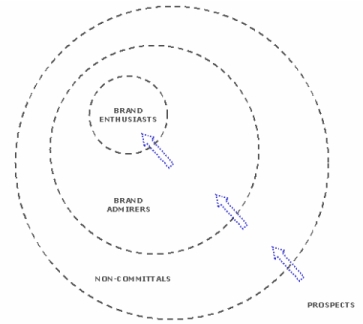The first version of this article was published in June 2004.
Download the PDF version of this white paper.
By David M. Kalman
How brand community media enhances marketing effectiveness – a Terrella Media White Paper
 Brand community is the term social scientists use to describe like-minded consumers who identify with a particular brand and share significant traits, which researchers Thomas C. O’Guinn and Albert Muniz describe as “shared consciousness, rituals, traditions, and a sense of moral responsibility.”1 The researchers show that consumers may organize into these communities to share their experiences of a brand. Conversely, consumers in an identifiable brand community represent a cohesive group that reflects the brand’s values.
Brand community is the term social scientists use to describe like-minded consumers who identify with a particular brand and share significant traits, which researchers Thomas C. O’Guinn and Albert Muniz describe as “shared consciousness, rituals, traditions, and a sense of moral responsibility.”1 The researchers show that consumers may organize into these communities to share their experiences of a brand. Conversely, consumers in an identifiable brand community represent a cohesive group that reflects the brand’s values.
The branding trade literature and research discusses several prototypical brand communities: Harley-Davidson riders, Saab drivers, Apple Computer enthusiasts, or Starbucks customers. It’s relatively easy for researchers to identify these consumers of high profile brands. But not every brand need be a Harley-Davidson or a Starbucks to have a brand community. By definition, affinity for a brand is personal: the consumers of Peet’s Coffee and Tea or other smaller or regional brands may be every bit as passionate about their brands. The minimum requirements for having a brand community seem to be:
- a brand that uniquely differentiates its consumers;
- mechanisms for consumers to engage in a public experience of the brand.
From these examples we can observe that the defining qualities of the brand are reflected in the consumers – and vice versa. For example, the Harley-Davidson brand stands for freedom, individuality, and rebelliousness. So it’s no surprise that those qualities are reflected in the typical leather-jacketed Harley-Davidson motorcycle rider.
What the research does not reveal so well is the degree to which consumers may aspire to (or adopt) a brand’s ideals even if they don’t embody them initially. For example, a buttoned-down business man may live vicariously through the Harley-Davidson brand. This is important to note because current and prospective brand community members embrace the brand identity in gradations from the non-committal to the true brand enthusiast.

A brand community model for marketing includes prospects considering a brand choice, non-committals who choose out of convenience or habit with no real preference, brand admirers who truly prefer a brand, and brand enthusiasts who both prefer and refer.
Consequently, a marketer’s job is in part to move consumers from the periphery to the center of the brand community, (i.e., to increase retention and revenue per customer) and also to attract new customers. This requires an expanded definition of brand community that goes beyond existing brand enthusiasts to include brand admirers (who truly prefer a brand), non-committals (who just happen to select a brand), and prospects (who have not yet decided to buy).
The branding trade literature also suggests some urgency for brand owners: when brand enthusiasts assert too much control over the brand message they can rebel against the brand owner and shut down new products or initiatives that contradict their values. Porsche experienced this kind of blowback with the introduction of its Boxter (too “low-end”) and Cayenne SUV (not a sports car!).
You’ll find similar examples in the brand communities of Apple Computer, BMW, and others. Brand communities have proven to be a powerful force, which leaves brand marketers with an imperative to cultivate relationships with members and to channel the consumers’ passions in directions that are helpful to the brand.
There are two major implications of the power of brand communities:
1. As visible consumers of a brand, brand community members can become its best promoters: Brand community members propel the brand message (and their enthusiasm for it) into the market and also act as the conduit for feedback from the market. Through surveys, focus groups, and analytics (of content interests), brand community members can become the source of valuable customer research.
2. Because a brand community represents a cohesive group, marketers can treat customers like subscribers or members and develop membership-oriented programs that deepen customer relationships.
- For the brand marketer, a membership model invites integrated communications programs that include magazines, websites and blogs, email news, e-books, live events, and other media components. Each component provides branding and promotional opportunities, and by combining them, marketers can amplify their effectiveness while lowering costs.
- For third-party marketers, brand communities represent a new way to find active buyers. By viewing brand communities as a true demographic indicator (analogous to gender, age, or income), third-party marketers can participate in the brand owner’s communications programs to reach active buyers at costs below traditional media.
Customers as Members
Brand community marketing isn’t new. Periodicals publishers and membership organizations have done it for years. Channel organizations in particular have pioneered reseller networks, conventions, publications, and more. These are all community-building programs, but on a business-to-business scale. What is relatively new is information technology: consumer brand marketers now collect considerable customer data and can use that data to build their own membership-oriented marketing communications programs.
The intersection of brand communities and information technology raises rich possibilities and a profound question: if marketers have customer data rivaling that of the media, then what is the nature of brand building? It begins to look more like audience development, and the basis of competition becomes the ability to attract and retain devoted members who in turn will transmit their brand enthusiasm to new prospects.
This is where we can apply lessons learned from publishing to the challenge of creating customer intimacy: by serving brand community members and prospects with useful and enlightening content delivered regularly, brand owners can:
- increase the time consumers spend enjoying a brand;
- articulate the brand message in a way that customers can transmit to new prospects;
- provide an interactive communication and research channel that tracks members’ interests over time;
- support ongoing promotions, e.g., for new products, and events;
- reduce advertising and promotions costs with programs that build upon each another.
A sample brand community media program could include a quarterly print magazine with distribution to customers and prospects. Distribution could range from 100,000 into the millions. This level of distribution provides economies of scale in production, but more importantly drives traffic to a website where marketers can close the loop, directing consumers to featured promotions and events, reserved content, discussion forums, and e-newsletter signups. The print audience can also serve as a database for direct marketing follow-up, as well as a research test bed with pop-up surveys and opt-in customer panels.
In this example, print distribution serves as the anchor for an integrated media solution that could include websites, e-books, live events, email newsletters, customer research, and direct marketing services. Print is especially useful in overcoming the limitations of email marketing for new customer acquisition. Other programs may be anchored by outbound email newsletters, where opt-in addresses are available.
To put this kind of program into context, a traditional direct marketing piece could cost from $.50 each for a postcard to a few dollars for a custom die-cut, high-end brochure. A typical three-piece mailer (brochure, envelope, and response vehicle) might cost $2.00, and an acceptable response rate might reach 2 percent. In contrast, an entire 68-page magazine and affiliated website can engage customers in a deeper interaction, spur discussion and action, and create an ongoing dialogue at a cost lower than typical direct mail pieces, of which 98 percent are ignored or discarded.
Conclusion
To unlock the full potential of brand communities, marketers must consider ways to add value to the consumer experience to earn the consumer’s attention outside the context of the purchase or use of the brand. If executed properly, brand community media provides this value by delivering useful and enlightening content that earns the consumer’s attention, encourages action and valuable feedback, and moves brand admirers, non-committals, and prospects further along the brand continuum.END
Sources: 1 “Brand Community,” by A.M. Muniz, Jr. and T.C. O’Guinn, Journal of Consumer Research, March 2001.
David M. Kalman is a content marketing innovator with more than 35 years of media experience. Kalman was formerly a Group Publisher at CMP Media and Miller Freeman, where he launched and managed magazines, Web sites, events, and other media including Intelligent Enterprise and Transform magazines. Previously, Kalman served as Editor-in-Chief of Data Based Advisor and DBMS magazines. Kalman served on the Western Publishing Association Board of Directors from 2004 to 2010.
View Kalman’s full profile on LinkedIn.

Comments are closed.